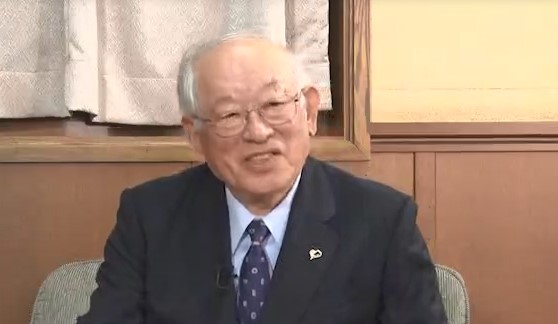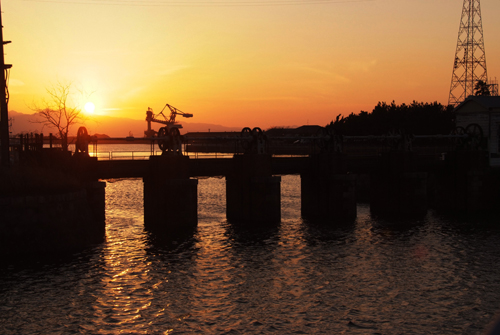PEOPLE
Former Mayor of Omuta City

Koga: That was a start. It was refreshing to hear Ms. Kato's 'new World Heritage terminology' at the seminar, such as OUV (Outstanding Universal Value), serial nomination, UNESCO's criteria of 'sanctity and integrity,' and so on. I was particularly shocked to learn that serial nomination refers to 'series' and that you can connect Kagoshima to Kamaishi within a series.
Kato: Everyone told me. “How can you put Hagi's Shokasonjuku Academy and Miike together, and what kind of concept is this? It is outrageous that they would spend money on something like this and issue a recommendation.”
Koga: Yes, it was. But, as Ms. Kato emphasised, "alone, they do not make a World Heritage Site, but if you put 23 heritage sites together in serial form, they become a World Heritage Site." Miike, with its active, working assets, is essential to the component parts in such a situation. It is not only Miike, but there are Yawata and the shipyard as well, but you said that it was not possible to make the operational assets a World Heritage Site within the existing framework, wasn’t it?
Kato: That is right. We received a tremendous backlash when we said that we could not do it under the existing rules and that we would reform the regulations and create a new framework. The World Heritage Department of the local government has people in charge who are knowledgeable about cultural heritage, and when one says to such a person, "Let's change the framework!" In a way, it was reckless of me to say such a thing to them.
Koga: The officials in the city hall did not think you could do it. However, that was the only way, so I decided to go ahead. Later, after receiving instructions from Ms. Kato, I submitted Omuta's idea on 23 June, and at a seminar on 3 August, Mr. Namba (then Deputy Director of the Regional Development Bureau) announced that “the Port of Miike could be managed under the Port and Harbour Law.” The Port of Miike and Port Promotion Office is located in Omuta City. The head of the office, seconded from the Kyushu Regional Development Bureau, put it all together.
Kato: On the morning of the seminar, news broke out that the Port of Miike was to be removed from the list of major ports, and you talked about making the Port of Miike a World Heritage Site within the framework of ports at such a difficult time.
At that time, I think everyone wondered what you were talking about. The rules had already been set that a World Heritage Site was a cultural property. A cultural property was either a historic site or an important cultural property. However, to change all those rules, to preserve it under the system of the Port Law, and to register it under a different framework without the Agency for Cultural Affairs' recommendation, was beyond reckless.
Koga: At the time, Governor Aso of Fukuoka Prefecture was very much against it. The port administrator of the Port of Miike is Fukuoka Prefecture. However, the actual management of the Port of Miike was carried out by the Port of Miike Logistics Co., Ltd. So, after about a month and a half, the Miike Port Promotion Office put together a policy. It states: 'Basic idea: to register the Port of Miike as a World Heritage Site in a way that does not affect the development of facilities and industrial activities at the Port of Miike'; 'Regarding the designation as a cultural property, there is a risk of restrictions on the current use pattern with cargo handling operations, repair and improvement of existing facilities, and future development and expansion plans for the port'; 'Third, the Port and Harbour Law's World Heritage Security: the authority under the Port Law allows port managers and others to manage the site appropriately while preserving its value as a World Heritage Site within the framework of the current law.’
Kato: It really would not have been possible without the system of port law. Because the shape of the Hummingbird is to preserve the surface of the water. The Law for the Protection of Cultural Property does not apply to the water's surface, so it is considered real estate, which is the project's base.
Then the harbour would be filled in without dredging, so we couldn't maintain the status quo under the system of cultural property. If the Ports and Harbors Bureau had not told us that we could protect it under the outline of the Port Law, we would have been out of the regulatory reform, and we would have suffered from the relationship with the Agency for Cultural Affairs by now. I guess we were lucky, but the most wonderful thing was that the mayor of Omuta was on board. He also did a great job of conveying the local opinion.
Koga: The head office of the Port of Miike Logistics Corporation known as the Nippon Coke Industry Co., Ltd. is located in Tokyo, and I went there. When I promised the then president, vice-president and others that the Port of Miike would be a World Heritage Site in a way that would not interfere with business at the Port of Miike, they agreed, and I sent an e-mail to Ms. Kato about it, who replied, "Thank you for negotiating with Nippon Coke Industry at the perfect time. " Governor Aso was also opposed to the project on the grounds that the cultural property would not allow free economic activity, but towards the end, he became more flexible.
Kato: I see. But when Governor Ogawa became governor, the prefectural government had a hard time at first. Still, Governor Ogawa is smart, and after meeting me several times, he quickly understood my explanation. At that time, I thought Governor Ogawa would be the most understanding person. After all, he was from the Ministry of Economy, Trade and Industry and knew that Mitsui's coal chemical complex, which pioneered Japan's heavy industry, was born here in Miike.
Koga: Yes, Governor Ogawa actively supported you. And then further regulatory reforms continued, did they not? I went to see Vice-Minister Hirano, but at that time, the government was run by the DPJ, but I sometimes wonder if it was possible because it was the DPJ-run government.
Kato: That is right. At the time, Ms. Renho was working hard on regulatory reform. He understood the easy-to-understand regulatory reform, ‘we would not apply the Law for the Protection of Cultural Properties.’ Hence, she helped accelerate the movement as long as the site would become a World Heritage Site within a different framework. Moreover, as Mayor Kitahashi is from the Democratic Party of Japan, Mr. Renho himself went to Yawata. Also, many people from unions knew the industrial scene as a workplace, so it was easy to get the story across. When Mr. Hirano went to meet with the mayor of Kamaishi on his third day as deputy minister, together with the mayor of Kamaishi, he said, "If this is the kind of framework, we can do it!" I explained to him, and he said, "The history of iron is my life's work. Your idea is interesting!" He immediately agreed with me.

Director, National Council of Industrial Heritage
President, Duke Estate Co.Ltd.
Representative Director, National Congress of Industrial Heritage
(Honorary Advisor, Kyushu Railway Company (JR Kyushu)
Senior Researcher, Industrial Heritage Information Centre
Honorary Advisor, Nippon Mining Co., Ltd.
The Ambassador of Supporting Kamaishi Hometown
Former Director of Nagasaki City World Heritage Office
Former General Manager, Nagasaki Shipyard and Machinery Works, Mitsubishi Heavy Industries, Ltd.
Chairman, Fujisankei Group
Executive Managing Advisor, Fuji Television Network, Inc.
Executive Managing Advisor, Fuji Media Holdings, Inc.
Advisor, Federation of Japan Port and Airport Construction Association
(Ex. Chairman of Specialists Center of Port and Airport Engineering)
Mayor of Nagasaki City
Former Director of the Sano Tsunetami Memorial Museum (currently known as Sano Tsunetami and the Mietsu Naval Dock History Museum)
Director of NPO Association for Thinking about Satoyama
Director of National Congress of the Industrial Heritage
Honorary Chief Priest Toshinari Ueda
Former Mayor of Omuta City
Archaeologist and Heritage Conservation Specialist
A fellow of the Japan Federation of Engineering Societies
Team Member of the Industrial Project Team Office for the Promotion of World Heritage Listing under Cabinet Secretariat
Governor of Kagoshima Prefecture
Mayor of Hagi City
Mayor of Uki City, Kumamoto Prefecture
The Former Employee of Nippon Steel Corporation
An Associate Professor of the Faculty of Science and Engineering in Iwate University
Chairman of the Tourist Guide Association of Misumi West Port
President of Kuraya Narusawa Co., Ltd.
Chairman of Izunokuni City Tourism Association
Director and General Manager of Gunkanjima Concierge
Producer of the Gunkanjima Digital Museum
Owner at Tōge Chaya
Chairman: Mr. Hidenori Date
President: Mr. Masahiro Date
Proprietor, Houraikan Inn
Representative Director of Egawa Bunko non-profit incorporated foundation
The 42nd head of the Egawa Family
Democratic Party for the People (DPP) Representative for Nagasaki Prefecture
President of the NPO, Way to World Heritage Gunkanjima
Representative Director
MI Consulting Group
President of Watanabe Production Group and Honorary Chair of Watanabe Productions Co., Ltd.
Member of the House of Councillors
Governor
Kagoshima Prefecture
World Heritage Consultant
Director and Dean, The Kyushu-Asia Institute of Leadership
Representative Director, SUMIDA, Inc.
Journalist, founder of the Shimomura Mitsuko Ikikata Juku School
Representative, Rally Nippon
Chairman, Sites of Japan’s Meiji Industrial Revolution World Heritage Route Promotion Council Director, National Congress of Industrial Heritage
Representative Director, General Incorporated Foundation National Congress of Industrial Heritage (Advisor, Public Interest Incorporated Foundation Capital Markets Research Institute)
Mayor of Nagasaki City
Policy Director at Heritage Montreal
World Heritage Consultant
Executive Director of Kogakuin University
Heritage Architect and International Consultant
Head of Data Acquisition at The Glasgow School of Art’s School of Simulation and Visualisation
Head of Industrial Heritage, Historic Environment Scotland, Edinburgh
Scottish Ten Project Manager, Historic Environment Scotland, Edinburgh
Mayor of Izunokuni City, Shizuoka Prefecture
Pro-Provost and Chairman of Council of the Royal College of Art. Heritage advisor of Canal & River Trust for England and Wales.
Dean of Tokyo Rissho Junior College
Professor emeritus of Keio University
Mayor of Kitakyushu City
At the 39th session of the World Heritage Committee convened in Bonn, Germany, from June 28 to July 8, 2015, the decision was approved to inscribe the Sites of Japan’s Meiji Industrial Revolution on the World Heritage list.
At a celebratory party held to mark the occasion, some of the primary promoters of the project spoke of their joy in achieving their goal and of the trials and tribulations to getting there.
Director and Managing Executive Officer, Hanshin Expressway Company Limited
Member, Board of Directors, National Congress of Industrial Heritage
Vice-Governor of Shizuoka Prefecture
Mayor of Hagi City
Chairman, Tokyo Metro Co., Ltd.
Mayor of Omuta City
Deputy Director-General, Lifelong Learning Policy Bureau, MEXT
Former Counsellor, Cabinet Secretariat
Mayor of Kamaishi City
Member, Board of Directors, National Congress of Industrial Heritage Counselor, Shimadzu Limited
Chairman of the Consortium for the World Heritage Inscription of Modern Industrial Heritage (Kyushu-Yamaguchi) and governor of Kagoshima Prefecture (as of 2015)